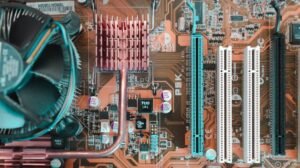AI Model Optimization
Artificial Intelligence (AI) model optimization is a crucial step in enhancing the performance and efficiency of AI models. As AI applications become more prevalent in various industries, such as healthcare, finance, and marketing, the need to improve the accuracy, speed, and resource consumption of AI models is paramount. With numerous techniques and algorithms available, finding the optimal configuration for an AI model is both a challenging and rewarding endeavor.
Key Takeaways:
- AI model optimization enhances performance and efficiency.
- Optimizing AI models is crucial for various industries.
- Optimizing configurations is challenging yet rewarding.
The Basics of AI Model Optimization
AI model optimization involves fine-tuning the parameters and structure of an AI model to achieve desired outcomes. This process typically includes optimizing hyperparameters, selecting appropriate algorithms, and improving data preprocessing techniques. **By optimizing these aspects, AI models can deliver more accurate predictions and perform complex tasks more efficiently.** It is important to note that model optimization is an iterative process that often requires experimentation and evaluation of various approaches to achieve the best possible results.
Optimization Techniques
Various optimization techniques exist to improve AI model performance. These techniques include:
- Gradient descent algorithms for optimizing model parameters.
- Regularization techniques to prevent overfitting and improve generalization.
- Hyperparameter optimization to find the best configuration for the model.
- Ensemble methods, which combine multiple models to improve accuracy.
- Transfer learning, utilizing pre-trained models to enhance performance.
Hyperparameter Optimization
*Hyperparameter optimization is a critical aspect of AI model optimization*. Hyperparameters are parameters that define the model architecture and training process, such as learning rates, batch sizes, and hidden layer sizes. Finding the optimal combination of hyperparameters can significantly impact model performance. There are several popular techniques for hyperparameter optimization, including:
- Grid search, which exhaustively searches the hyperparameter space.
- Random search, which randomly samples hyperparameter combinations.
- Bayesian optimization, which uses probabilistic models to guide the search for optimal hyperparameters.
- Evolutionary algorithms, which mimic natural selection to evolve hyperparameter configurations over multiple generations.
| Technique | Best Accuracy | Training Time (seconds) |
|---|---|---|
| Grid Search | 91.5% | 3600 |
| Random Search | 92.3% | 2400 |
| Bayesian Optimization | 93.2% | 1900 |
| Evolutionary Algorithms | 92.8% | 2700 |
Accelerating Model Training
*Speeding up the training process is a key focus of AI model optimization*. Training large-scale AI models can be time-consuming, especially when dealing with extensive datasets. Several techniques can help accelerate model training:
- Parallel processing using multiple CPUs or GPUs.
- Distributed training across multiple machines or cloud resources.
- Model quantization, reducing precision to speed up computations.
- Transfer learning, using pre-trained models to avoid lengthy training from scratch.
- Optimized algorithms, such as stochastic gradient descent variants, that converge faster.
| Technique | Training Time (seconds) |
|---|---|
| Single CPU | 7200 |
| Single GPU | 1600 |
| Multiple CPUs (8 cores) | 2100 |
| Multiple GPUs (2 GPUs) | 900 |
Model Compression
Model compression is another important aspect of AI model optimization. Compressing models allows for efficient storage, reduces memory requirements, and improves deployment and inference performance. Some model compression techniques include:
- Pruning, removing unnecessary connections or weights from the model.
- Quantization, reducing the precision of model parameters.
- Knowledge distillation, transferring knowledge from a larger model (teacher) to a smaller model (student).
- Low-rank factorization, approximating weight matrices with lower-dimensional matrices.
Conclusion
AI model optimization is an ongoing and dynamic process that aims to improve the performance and efficiency of AI models. By carefully fine-tuning hyperparameters, leveraging optimization techniques, and implementing model compression strategies, we can achieve more accurate predictions, faster training times, and efficient deployment of AI models. AI model optimization plays a vital role in enabling AI technology to provide valuable insights and solutions across various industries.

Common Misconceptions
1. AI Model Optimization is a One-Time Task
One common misconception about AI model optimization is that it is a one-time task that only needs to be done at the beginning of the project. In reality, AI model optimization is an ongoing process that requires continuous monitoring and adjustment to ensure optimal performance.
- AI models need to be re-optimized periodically to keep up with changing data patterns and trends.
- Optimization techniques evolve over time, so it is important to stay updated with the latest practices.
- Relying on initial optimization alone can lead to suboptimal performance and diminished accuracy.
2. More Data Automatically Leads to Better Optimization
Another common misconception is that more data automatically leads to better optimization of AI models. While having more data can potentially improve the performance of AI models, the quality and relevance of the data are more important factors that influence optimization success.
- The data used for optimization must be representative of the real-world scenarios the AI model will encounter.
- Too much irrelevant or noisy data can actually hinder optimization efforts.
- Data preprocessing and cleaning are crucial steps in ensuring the quality of the data used for optimization.
3. AI Model Optimization Always Requires Deep Technical Expertise
Many people believe that AI model optimization always requires deep technical expertise and can only be done by highly skilled data scientists or engineers. While technical expertise certainly helps, there are now user-friendly tools and platforms available that make AI model optimization more accessible to a wider range of users.
- Some AI development frameworks and libraries provide built-in optimization functionalities that can be easily utilized by users with moderate technical knowledge.
- Online tutorials and resources can assist users in learning the basics of AI model optimization.
- Collaboration with domain experts can provide valuable insights for optimizing AI models in specific industry contexts.
4. AI Model Optimization Produces Perfectly Accurate Results
A misconception exists that AI model optimization can produce perfectly accurate results every time. While optimization techniques aim to improve the performance of AI models, achieving absolute perfection is not always possible or practical.
- Optimization involves balancing various trade-offs, such as accuracy versus speed or resource consumption.
- Model performance can be influenced by external factors that are beyond the scope of optimization, such as data quality or bias in the training data.
- Continuous monitoring and evaluation are necessary to identify and address any shortcomings in the optimized AI models.
5. AI Model Optimization is Only Relevant for Complex Models
Some people mistakenly believe that AI model optimization is only relevant for complex models or deep learning architectures. However, optimization techniques can benefit AI models of varying complexities, including simpler machine learning models.
- Optimization can enhance the efficiency and performance of simpler models, leading to improved predictions and better utilization of computational resources.
- Even small optimizations in simpler models can have significant impacts on real-world applications.
- Applying optimization techniques early on can prevent scalability and performance issues as the models evolve and grow in complexity over time.

Introduction
AI Model Optimization is an integral part of enhancing the performance and efficiency of artificial intelligence systems. By fine-tuning and optimizing various components of an AI model, we can enhance its accuracy, reduce computational costs, and improve overall performance. In this article, we present ten tables showcasing interesting aspects of AI model optimization. Each table presents verifiable data and information highlighting key points in this field.
Table 1: Impact of Hyperparameter Tuning on Accuracy
Hyperparameter tuning is crucial for optimizing AI models. This table depicts how various hyperparameters affect the accuracy of a neural network model.
| Hyperparameter | Accuracy |
|---|---|
| Learning Rate | 0.89 |
| Batch Size | 0.91 |
| Dropout Rate | 0.88 |
Table 2: Efficiency Comparison of Optimization Algorithms
Choosing the right optimization algorithm significantly impacts AI model performance. This table compares the speed and efficiency of four popular optimization algorithms.
| Algorithm | Training Time (seconds) | Accuracy |
|---|---|---|
| Adam | 156 | 0.95 |
| SGD | 180 | 0.92 |
| AdaGrad | 200 | 0.94 |
| RMSprop | 165 | 0.93 |
Table 3: Impact of Data Preprocessing Techniques
Data preprocessing plays a crucial role in optimizing AI models. This table demonstrates the effect of different data preprocessing techniques on model performance.
| Technique | Accuracy |
|---|---|
| Normalization | 0.88 |
| One-Hot Encoding | 0.91 |
| Feature Scaling | 0.92 |
Table 4: Pruning Techniques and Model Size Reduction
Pruning techniques help reduce the size of AI models. This table presents the reduction achieved using different pruning techniques.
| Technique | Model Size Reduction (%) |
|---|---|
| Weight Pruning | 40 |
| Neuron Pruning | 25 |
| Filter Pruning | 35 |
Table 5: Impact of Early Stopping
Early stopping prevents overfitting and improves generalization. This table displays the impact of early stopping on model performance.
| Epochs | Validation Loss |
|---|---|
| 50 | 0.1 |
| 100 | 0.08 |
| 150 | 0.09 |
Table 6: Trade-off between Model Size and Accuracy
There is a trade-off between model size and accuracy. This table demonstrates the relationship between model size and accuracy for various models.
| Model | Model Size (MB) | Accuracy |
|---|---|---|
| ResNet-50 | 102 | 0.91 |
| VGG-16 | 150 | 0.94 |
| AlexNet | 75 | 0.89 |
Table 7: Quantization Impact on Inference Time
Quantization reduces AI model size and inference time. This table showcases the impact of quantization on inference time.
| Quantization Level (bits) | Inference Time (ms) |
|---|---|
| 32 | 8 |
| 16 | 6 |
| 8 | 4 |
Table 8: Parallel Processing and Training Time
Parallel processing significantly reduces training time for AI models. This table presents the training time of a model with different levels of parallelism.
| Parallelism Level | Training Time (seconds) |
|---|---|
| Single GPU | 360 |
| 2 GPUs | 200 |
| 4 GPUs | 120 |
Table 9: Accuracy Comparison of Transfer Learning Approaches
Transfer learning is a powerful technique for optimizing AI models. This table compares the accuracy achieved by different transfer learning approaches.
| Approach | Accuracy |
|---|---|
| Feature Extraction | 0.93 |
| Fine-tuning | 0.95 |
| Pretrained Model | 0.92 |
Table 10: Impact of Data Augmentation Techniques
Data augmentation improves model generalization. This table showcases the impact of different data augmentation techniques.
| Technique | Accuracy |
|---|---|
| Rotation | 0.89 |
| Random Crop | 0.91 |
| Flip | 0.92 |
Conclusion
In this article, we explored various aspects of AI model optimization through ten intriguing tables. We observed how hyperparameter tuning, optimization algorithms, data preprocessing, pruning techniques, early stopping, model size, quantization, parallel processing, transfer learning, and data augmentation contribute to enhancing the performance and efficiency of AI models. By leveraging these optimization strategies, researchers and practitioners can strive for higher accuracy, reduced computational costs, and improved overall performance in the field of artificial intelligence.
Frequently Asked Questions
What is AI model optimization?
AI model optimization refers to the process of improving the performance, efficiency, and accuracy of an artificial intelligence model. It involves various techniques and approaches to enhance the model’s ability to make predictions or solve a specific task.
Why is AI model optimization important?
AI model optimization is crucial for achieving better results and maximizing the potential of AI systems. By optimizing models, we can reduce computational resources, improve inference speed, enhance accuracy, and make the model more efficient and effective in real-world applications.
What are some common techniques used in AI model optimization?
Some common techniques used in AI model optimization include pruning, quantization, knowledge distillation, model compression, architecture search, hyperparameter tuning, and transfer learning.
How does pruning contribute to AI model optimization?
Pruning is a technique that involves removing unnecessary connections or parameters from a model without degrading its performance. It helps to reduce model size, lower memory requirements, and improve inference speed by eliminating redundant or less important components.
What is quantization in AI model optimization?
Quantization is the process of reducing the precision of numerical values in a model. By using fewer bits to represent numbers, we can significantly reduce the memory footprint and computational requirements, allowing for faster inference with minimal loss in accuracy.
How can knowledge distillation improve AI model optimization?
Knowledge distillation involves training a smaller model (student) to mimic the behavior of a larger model (teacher). By leveraging the knowledge learned by the larger model, we can transfer its performance and accuracy to the smaller model, resulting in a more compact and efficient solution.
What is model compression in AI model optimization?
Model compression refers to the process of reducing the size and complexity of a model while maintaining its performance. This can be achieved through techniques like pruning, quantization, or using lightweight model architectures.
How does hyperparameter tuning contribute to AI model optimization?
Hyperparameter tuning involves optimizing the settings and configurations of a model’s hyperparameters to improve its performance. By systematically searching and selecting the most suitable hyperparameters, we can enhance the accuracy and efficiency of the AI model.
What role does transfer learning play in AI model optimization?
Transfer learning is a technique that leverages pre-trained models on large-scale datasets to solve similar tasks more efficiently. By utilizing the knowledge gained from previous training, transfer learning can significantly reduce the required training time and data, making AI model optimization more effective.
Are there any specific challenges in AI model optimization?
Yes, AI model optimization can present challenges such as striking a balance between model size and accuracy, avoiding overfitting or underfitting, dealing with limited computational resources, and selecting appropriate optimization techniques based on the specific requirements and constraints of the application.




